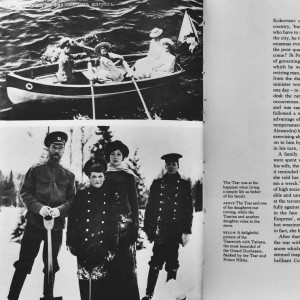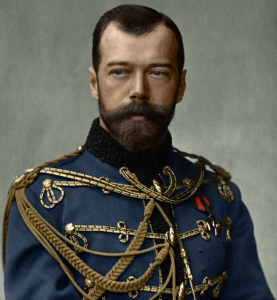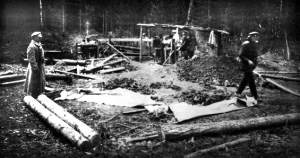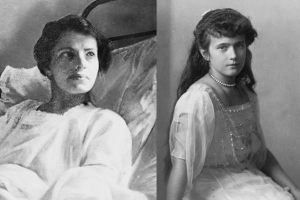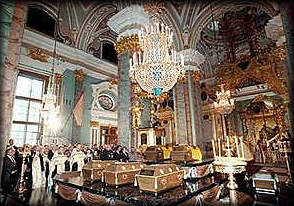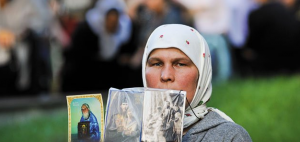Research Guide by Annalise Routenberg
Portrait of the Romanov family, 1913
Introduction
The Romanov Dynasty ruled over Russia imperially for over three hundred years. The family’s legacy spans from Peter the Great and his efforts in bringing Russia out of the Middle Ages, all the way up to the last Tsar Nicholas II, his wife and children, and their twisted and unfortunate demise in 1918. The death of the last imperial family changed the leadership system in Russia forever, and brought waves of different reactions from people around the world.
Undoubtedly due to the horrific and initially mysterious nature of the murders, the world’s general fascination with the last of the Romanovs has yet to completely die down. The Romanov family left an undeniable mark on Russia and the world, which is evident not only through the great following their story continues to have.
Writers and historians of all kinds have composed both reliable and unreliable literature on the matter, prompting the question of “why?” to be raised.
This research guide provides a historian with a comprehensive list of both print and online sources from which to draw information about the Romanov dynasty’s memory and impact on the world, and to search for a conclusion as to why they have remained a cultural phenomenon almost one hundred years after their deaths. This guide addresses the Romanov’s infamy from cultural, international, religious and scientific standpoints.
General Russian Historical Context
RUSSIA AND THE USSR IN THE TWENTIETH CENTURY
Though this text focuses primarily on the evolution of Russia throughout the 1900s as a whole, MacKenzie and Curran highlight important and relevant points that have to do with linking Tsarism and the Russian Orthodox Church. They go on to explain the separation of church and state, as well as where orthodoxy came into play during years of soviet rule, up until nearly present day.
David MacKenzie and Michael W. Curran, Russia and the USSR In the Twentieth Century. (Belmont, CA: Wadsworth. 2002. Print)
RUSSIA: A HISTORY
This source covers centuries of Russian history, but Freeze does make some insightful connections regarding the height of Tsarism and the end of imperial rule in Russia, as well as church and civil laws that came into play after the death of the monarchs. This overview of Russian history gives readers room to interpret events and their causes that proved to be socially revolutionary.
Gregory L. Freeze, Russia: A History. (Oxford: Oxford University Press. 1997. Print)
Members of the Imperial family, 1916
MARGINALIA, LOS ANGELES REVIEW OF BOOKS
This article on the relationship between church and state throughout Russian history provides important historical context for a researcher interested in studying the Russian Orthodox Church and it’s affects on the nation’s identity. Simon Rabinovitch clarifies the differences between Russian identities in terms of nationality and in terms of religious affiliation. He acknowledges that leaders from the latter half of the Romanov Dynasty directly linked Russian nationality with belonging to the Russian Orthodox Church. Rabinovitch also comments on the challenges this created for the Bolsheviks in their attempts to disconnect Russian national identity from the Orthodox Church following the fall of the Romanov Dynasty.
“Searching For The Meaning Of ‘Russian’”, Simon Rabinovitch, The Marginalia Review Of Books, Accessed November 27, 2014, last modified July 2, 2013.
http://marginalia.lareviewofbooks.org/searching-for-the-meaning-of-russian-by-simon-rabinovitch/
Romanov Rule
THE ROMANOVS: AUTOCRATS OF ALL THE RUSSIAS
Unlike the typical, praise-filled writings on the last imperial family, Bruce Lincoln’s collection of historical events and facts give a reader a full understanding of the development, ruling and eventual end of the Romanov Dynasty, and the years that followed their deaths. Lincoln outlines the way the last Tsar, Nicholas II, was raised and specifies his lack of preparedness for the task he was given. As well as highlighting where the Romanovs fell short as leaders and as human beings, he begins to look into where Lenin, Stalin and Trotsky ran into problems with the new nation and how they in turn combated them.
Bruce W. Lincoln, The Romanovs: Autocrats Of All Russia.
(New York: Dial, 1981. Print)
Tsar Nicholas II
ROMANOVS: FINAL CHAPTER
This text explains the manners in which the death of the family and later investigations of the murder were handled by the Russian people and the world. Massie explores the ways in which the deaths were initially handled by the Russian government, acknowledging that information was released to the general public slowly, and not always truthfully. Romanovs: Final Chapter also touches upon the international stage, with a focus on German interest in the matter the years directly after the murder, and the rest of the world for years to come.
Robert K. Massie, Romanovs: Final Chapter.
(Random House Group, 2012. Print)
THE LAST DAYS OF IMPERIAL RUSSIA
Miriam Kochan’s The Last Days Of Imperial Russia serves to educate a historian further on what the Romanov family did and did not do that caused the fall of their empire. Imperial Russia’s demise is placed on the shoulders Nicholas Romanov, his wife Alexandra, Rasputin, even Tsarnevich Alexis, the youngest Romanov son.
Miriam Kochan, The Last Days Of Imperial Russia. (New York: Macmillan, 1976. Print)
ENCYCLOPEDIA BRITANNICA ONLINE
The Encyclopedia Britannica provides some very basic, but useful information on the Romanov Dynasty and their impact on Russia. Through Britannica Online, a researcher can easily access related articles and sources because they are made readily available based on the topics.
“Romanov Dynasty”, Encyclopedia Britannica Online, accessed November 29 2014, last modified August 4, 2014. http://www.britannica.com/EBchecked/topic/508643/Romanov-Dynasty
Public Fascination and Obsession
THE SOLOKOV INVESTIGATION OF THE ALLEGED MURDER OF THE RUSSIAN IMPERIAL FAMILY
Arguably the most in depth investigation of the Romanov murder, Solokov’s research shows the high level of obsession behind the family and their deaths. Solokov analyzed what appears to be every detail imaginable, focusing mainly on the Bolsheviks involved in the murder and their processes in doing so. The investigation was something that generated interest among the Russian people, as well as around the world, thereby continuing to generate interest in the Romanov family. The investigation went on for about fifty years following the death of the family.
Nicholas A. Solokov and John F. O’Connor, The Solokov Investigation Of The Alleged Murder Of The Russian Imperial Family. (New York: Robert Speller and Sons, 1971. Print)
Basement room in Ipatiev house where the Romanovs were executed
The Solokov investigation searching for the family’s remains.
ANASTASIA: THE RIDDLE OF ANNA ANDERSON
A detailed account of the life of a woman claiming to be the long-lost Grand Duchess Anastasia, The Riddle Of Anna Anderson should be used by researchers as more of a historical artifact of thought, rather than actual evidence by any stretch of the word. It is a great tool in understanding the obsession behind the “myth and mystery” of the Romanov “disappearance”, but as far as historical accuracy goes, this text should be considered unreliable. The existence of this book is frivolous for many reasons, but mainly because Anastasia’s remains have been discovered, unsurprisingly, along with the rest of her deceased family. However, this text serves as a prime example of the ways that the alluring memory of the Romanov story influences historians and writers to produce more and more literature on the subject, albeit not always completely accurate.
Peter Kruth, Anastasia: The Riddle Of Anna Anderson. (Toronto: Little, Brown and
Company. 1983, Print)
Anna Anderson (left), who claimed she was the long-lost Grand Duchess Anastasia (right).
VIDEO: THE ROMANOV BURIAL, https://www.youtube.com/watch?v=8oYHKLHGwvA
This video is the live broadcast of the memorial service and burial of the Romanov family’s remains, which took place in 1998. The same YouTube account, “Tsarevich Alexei”, has three videos covering the majority of the broadcast. All three videos, (parts 1,2 and 3) are very helpful in understanding traditional Russian culture and the procedures for a royal burial. In the videos, the coffins are carried very traditionally and systematically, with music playing and soldiers present. Unfortunately the videos contain no subtitles, but President Yeltsin spoke at the service. The burial occurred at Saint Catherine’s Chapel, which appears to be exceptionally beautiful and traditional in the videos. In the video labeled “Part 3”, the coffin of Tsar Nicholas II is laid to rest. It is apparent that the Tsar’s coffin has a bit more decoration. The third segment also provides a visual on the cannons that were being fired, presumably a tradition of a royal burial, and shows clips of the Fortress.
Coffins containing the Romanov family remains, inside the Saint Catherine’s Chapel in St. Petersburg
BBC NEWS: WORLD EDITION
This article from BBC online lays out the details of the burial of the Romanov family’s remains in 1998. There is a small recap of the speech that President Boris Yeltisn gave on the live broadcast, as well as an excerpt of a quotation from Prince Nikolay Romanov, one the last living relatives of the imperial family. The article also touches upon the dispute over the legitimacy of the remains that were discovered, which resulted in several bishops being unable to participate in the burial ceremony.
“Romanovs Laid To Rest”, BBC News Online, accessed November 20 2014, last modified July 17, 1998. http://news.bbc.co.uk/2/hi/europe/133725.stm
SMITHSONIAN MAGAZINE ONLINE
Joshua Hammer, in his article titled “Resurrecting the Czar”, gives an in-depth explanation of what happened to the Romanov family in 1918, and does an even better job of chronicling the events that followed the murders for the next hundred years. He writes about the extensive research that was done in discovering the family’s remains, and the DNA analysis that appeared controversial to many who closely followed the Romanov’s saga. Due to the discovery of the remains, disparities between the Russian Orthodox Church and the investigators and scientists began appearing, and came to a head at the time of the burial ceremony of the imperial family’s remains. Hammer provides details on the relationship between the Romanovs and the Orthodox Church, claiming the linkage is very apparent in the way the church’s displays honoring the family, and in the family’s canonization as “martyrs” and “passion bearers”. Something important that this article addresses is the ideology of a “monarchist”, or someone who argues for the reinstatement of the monarchical system.
“Resurrecting The Czar” Smithsonian Magazine Online, accessed November 25, 2014, last modified November 2010. http://www.smithsonianmag.com/people-places/resurrecting-the-czar-64545030/?no-ist=&c=y&page=1
Present-day monarchist, holding photos and icons of the imperial family.
Russian Orthodox Church
A CONCISE HISTORY OF RUSSIA
A text such as this, covering Russian history spanning hundreds of years, up until just about present day, could prove invaluable to a researcher. Throughout the book there is a general focus on the changes in regimes and leadership over the years, but Bushkovitch makes room to include short explanations of patterns of social events and the church’s big moments, along with those of the state. Because Bushkovitch published this book in 2012, he was able to briefly cover the canonization of the victims of the Bolshevik takeover, including the Romanov family.
Paul Bushkovitch. A Concise History Of Russia.
(Cambridge University Press, New York. 2012. Print)
BBC NEWS: WORLD EDITION
In this article from August of 2000, the details of the canonization of the Romanov family are clearly outlined on BBC online. Due to the family’s supposed “patience and humility”, they were canonized as saints in the Orthodox Church, along with many others who faced difficulties and death during the rebellions in the early 20th century. According to BCC, the church felt compelled to explain that the Tsar and his family were canonized based on the way they were killed, and not necessarily because of their monarchical status. Because of their unpopularity among much of the Russian population, their canonization seemed unreasonable to some.
“Sainthood For Last Tsar”, BBC News Online, accessed November 20 2014, last modified August 14, 2000. http://news.bbc.co.uk/2/hi/europe/880205.stm
STALKING THE HOLY: THE PURSUIT OF SAINT MAKING
Though Higgins provides a considerable amount of information on many religious practices, churches and saints, he dedicates numerous pages to the canonization of the Romanov family in the year 2000, along with hundreds of other victims of the murders of the Bolshevik rebellion. The Russian Orthodox Church’s decision to canonize the last imperial family was met with some opposition. Critics cited Nicholas II’s abdication of the throne as a major factor in allowing the rise of communism, and also questioned the idea of making them saints, based on the fact that no “miracles” occurred to suggest they were holy or should be canonized. On top of these questions, people wondered about the legitimacy of the family’s remains that were discovered. The Russian Orthodox church combated these remarks by explaining that the canonization of the Romanovs would not be considered an appropriation of the former regime or an argument for it’s reestablishment, but rather a nod to the Romanov family’s continual support and following of the Orthodox church and their “passion-bearing” behaviors.
Michael W. Higgins, Stalking The Holy: The Pursuit Of Saint Making
(House Of Anansi Press, Toronto, ON. 2006. Print)
The Imperial Family, canonized in 2000, pictured as saints
OUTLINES OF RUSSIAN CULTURE, PART I: RELIGION AND THE CHURCH
Because it was published in 1942, this text does not provide any basic history past then, but it does offer important information about the changes made to the Russian Orthodox Church before, during, and especially after the reign of the Romanovs. The revolutions in the early 20th century brought about many challenges for the Orthodox Church, and even more once the monarchy had been dismantled. The Romanovs were dedicated in their religious habits, and therefore the church influenced many of their decisions while in power. As they fell out of power, the church followed suit and lost control of many aspects of life in Russia.
Paul Miliukov, Outlines Of Russian Culture, Part I: Religion And The Church.
(University Of Pennsylvania Press, Philadelphia, 1942. Print)

